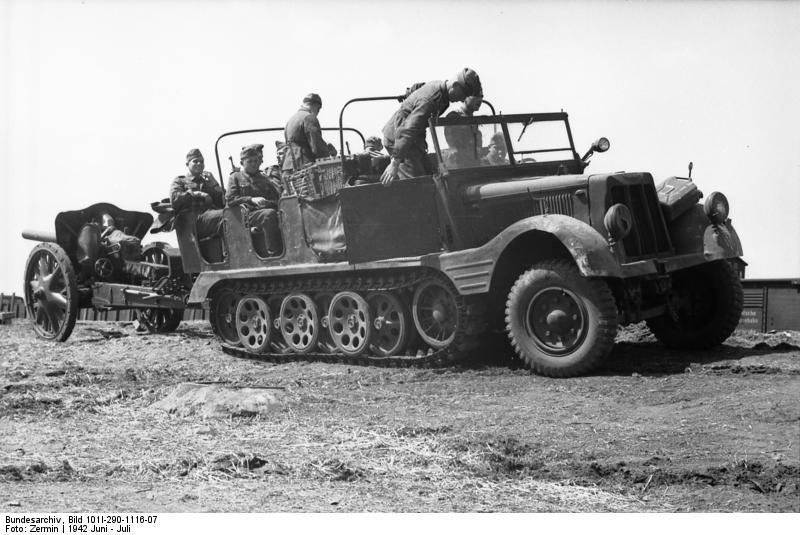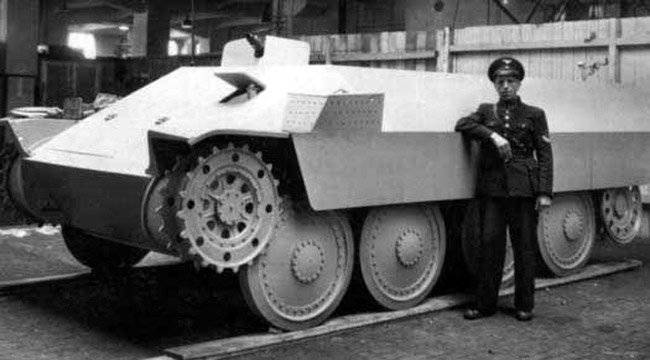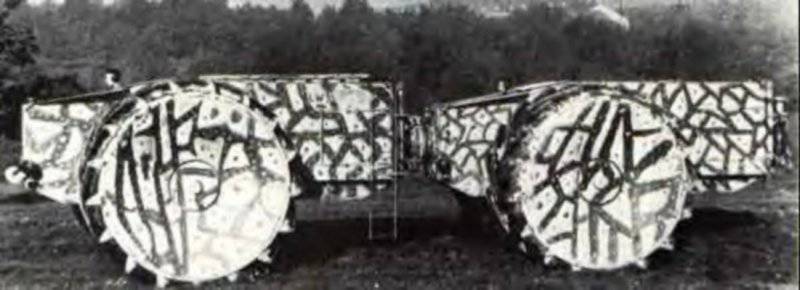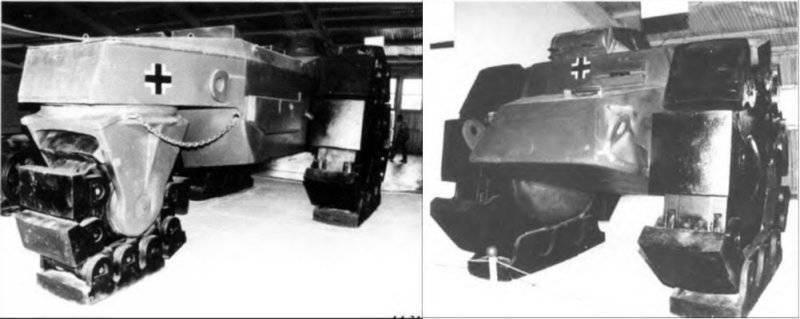German projects "special equipment"
Tractors
It is difficult to imagine the fields of the Second World War without artillery. However, "in the shadow of" the guns themselves remained their means of support, if I may say so. Obviously, a towed gun without a tractor will lose most of its potential. In the German leadership, this was well understood and constantly attempted to do something that should have replaced the good old tractors Sd.Kfz.6 and Sd.Kfz.11.

Since 1942, the German Department for the Study of Engineering Equipment has conducted two promising tractor programs. It should be noted that some bright heads from this organization came up with an original idea - you need to make not just an artillery tractor, but an armored one and with the possibility of using it as a repair and recovery vehicle. In this case, in their opinion, the Wehrmacht would have received a universal apparatus "for all occasions." The idea looks rather doubtful, because excessive universalization sometimes leads to problems. But the Department decided that way. The first technical task for a wheeled tractor was received by the Stuttgart company Lauster Wargel. The main requirement for the new machine concerned high mobility and high power density. To enable the towing of padded tanks traction was supposed to be in the region of 50 tons. Also, the chassis of the tractor had to be adapted to the off-road of the Eastern Front.
Prototype tractor LW-5
In 1943, the prototype of the LW-5 tractor was tested. It was connected to several original ideas. So, instead of the usual tracked chassis for such a technique was used wheel. The wheels themselves were made of metal and had a diameter of about three meters. Ensuring maneuverability was assigned to the articulated circuit. For this, the LW-5 consisted of two parts connected by a hinge. Each half had not only its own pair of wheels, but also its own engine. It was a Maybach HL230 petrol with horsepower 235. The crew of two people and the engine compartment were protected by armored corps. There is no information about the thickness of the sheets and their material. Separately, it is worth noting the fact that in front of each "module" of the LW-5 tractor were crew jobs. In addition, in front and behind they were equipped with hitch systems. Thus, as conceived by the designers of Lauster Wargel, several “modules” or tractors could be combined into one long machine with the appropriate capabilities. With the tonnage received on the tests in 53 (one tractor from two blocks) it is not difficult to guess about the capabilities of a composite “train” of several LW-5.
Only the capabilities of the car as a tractor could not outweigh the disadvantages. Representatives of the Wehrmacht considered the maximum speed of a little more than 30 kilometers per hour to be inadequate, and the weak booking of the hull and the virtually unprotected hinge only confirmed doubts about the expediency of the project. In the middle of 1944, the LW-5 project was closed. Until the end of the war, all the developments of Lauster Wargel on articulated technology lay in the archives. They were useful only a few years later, when some companies began to develop such civilian vehicles.
No less unsuccessful was another project of a new multifunctional tractor. Only in the case of the project of the company Auto Union, which received the name Katzhen, the tractor was trying to "cross" with an armored personnel carrier. The tracked vehicle was supposed to carry up to eight personnel and a towed gun, as well as accelerate to 50-60 km / h and protect the crew from bullets and shrapnel. Designers Auto Union made the design of its armored carrier-tractor from scratch. The pyatikatkovaya chassis was based on the Maybach HL50 motor on the 180 hp.

In 1944, two prototypes of the Katzhen machine were manufactured. Good for such tasks booking (30 mm forehead and 15 mm board) attracted representatives of the German army. However, the engine and transmission were clearly inappropriate to the assigned tasks. Because of this, an armored personnel carrier-tractor could not fulfill even half of the demands made on it. Auto Union project closed down. A little later, several experimental machines of similar purpose were assembled as a replacement for the not-made Katschen. This time, with a new chassis, they decided not to subtilize it and took it from a light tank Pz.Kpfw.38 (t). The new tractor with the ability to transport "passengers" turned out to be simpler and fulfilled most of the requirements. However, it was already late and the second version of the Katzhen project was also discontinued due to lack of prospects.
Minesweepers
From the very beginning of the Second World War, the German military faced the issue of making passages in minefields. These actions were charged to sappers, but over time, mine trawls appeared. In addition, during the war several original and interesting self-propelled machines of similar purpose were created.
The first was Alkett Minenraumer. In 1941, Alkett, with the assistance of Krupp and Mercedes-Benz, began building a self-propelled minesweeper. As conceived by the engineers, this vehicle was supposed to destroy the enemy’s anti-personnel mines by tripping them. For this armored car was equipped with three wheels. The front two were leading and had a diameter of the order of 2,5 meters, and the rear controlled was two times smaller. In order to avoid changing the entire wheel after each explosion, trapezoidal support platforms were placed on the rim, ten on the drive wheels and 11 on the steering wheel. The system acted like this. Platforms mounted on hinges literally stepped on a mine and put pressure push fuse into action. Anti-personnel mine exploded, but did not cause damage to the machine itself, but only deformed the platform. The body of the apparatus Alkett Minenraumer was based on the armored hull of the PzKpfv I tank. The front half was left from the tank hull and the rest was redone. Together with the characteristic contours of the forehead of the tank, Minenraumer received a turret with two machine guns. In the part of the minesweeper “attached” to the half of the tank hull, the engine and transmission compartment with a Maybach HL120 engine and 300 hp was placed. The crew of the car consisted of a driver and commander-shooter.
In 42, Alkett Minenraumer went to the test. Documents with their results did not survive, but the only built sample after the war was tested in Kubinka. When driving on soft ground, the device quickly got stuck and the 300 "horses" of the motor could not even provide the calculated 15 km / h. In addition, the very idea of "crushing" the mines with wheels caused doubts, because when undermined, the crew is exposed to several adverse effects. Soviet engineers recognized the project as unpromising. Judging by the absence of the Minenraumer on the margins of World War II, the German decision makers felt the same. The only prototype was sent to the far corner of the landfill, where it was discovered by the Red Army.
About a year later, Krupp, taking into account all the shortcomings of the three-wheeled anti-mine device, presented its project. This time, the car was a cross between an Alkett Minenraumer and a LW-5 tractor. 130-ton (design gross weight) four-wheel monster also had to literally crush mines. The principle of operation was borrowed from the previously described minesweeper, with the difference that the Krupp Raumer-S (as they called this machine) had fixed support platforms. The miracle on 270-cm wheels was driven by a Maybach HL90 engine with 360 horsepower. Since it was not possible to ensure the normal rotation of the wheels with a mass of 130 tons, the designers of Krupp used an articulated circuit. However, unlike LW-5, there were no knots for “lengthening” the machine. But if necessary, Raumer-S could work as a heavy tractor, for which he had the appropriate equipment. It is noteworthy that the designers immediately understood the low maneuverability of the future machine. Therefore, most likely, for a more convenient and quick return from the minefield, Raumer-S was equipped with two cabins in the front and rear. Thus, one driver-mechanic made a pass in the minefield, and the second returned the car back without losing time for turns.
According to available information, Krupp Raumer-S managed to ride around the landfill. However, he was pursued exactly the same problems as the minesweeper from Alkett. The large mass and low power density made of the original idea something complex and unwieldy. In addition, combat survivability raised questions - the enemy is unlikely to calmly look at how an incomprehensible machine drives through a minefield in front of its positions. So even the second cabin would not have saved the Raumer-S — he would have “caught” his two or three shells long before the end of the passage’s clearance. At the same time, there were doubts about the preservation of the crew’s health after the mines exploded. As a result, according to the test results, another minesweeper project was closed. Sometimes there is information that Krupp Raumer-S managed to take part in hostilities on the Western Front, but there is no documentary evidence of this. The only 130-ton giant made became the Allied trophy.
Realizing the futility of the seemingly promising idea at Krupp, they returned to the project of another minesweeper, a simpler and more familiar design by today's standards. Back in 1941, it was proposed to take a serial tank and make a trawl for it. Then the project was considered unnecessary and froze, but after failures Raumer-S to him had to go back. The trawl itself was extremely simple - a few metal rollers and a frame. All this had to be attached to the tank and the passage was done without much risk for the armored vehicle. At the same time, the features of the combat work of the crew of the Raumer-S, which every now and then risked getting injured, were still remembered. Therefore, it was decided to take the PzKpfw III tank as a base and make it a more mine-friendly machine. To this end, the chassis of the original tank was significantly reworked, which increased the clearance by almost three times. In addition to the advantages in maintaining the health of the crew, this decision gave the minesweeper Minenraumpanzer III a distinctive appearance.
In 1943, Minenraumpanzer III was brought to the landfill and began to experience. Trawl worked perfectly. Almost all types of mines existing at that time with push-type fuses were destroyed. But to the "carrier" of the trawl any questions. Thus, the high center of gravity made one doubt the stability of the armored vehicle when cornering, and the trawl disks tended to collapse after several mines destroyed. Fragments of the disks under unfavorable circumstances could penetrate the frontal armor of the Minenraumpanzer III and lead to dire consequences. Anyway, on the basis of the results of the ground tests, the new minesweeper was also not launched into the series.
Remote controlled equipment
The third direction of technical "exotic", which is worth paying attention to, concerns distance-controlled vehicles. At the beginning of the war, the “land tracked torpedoes” of the Goliath family were created. Relatively small tracked vehicle, controlled by wire, was originally intended for the destruction of enemy tanks. However, over time, it began to be used as an engineering tool, for example, for the destruction of any obstacles.
Based on a single layout, several versions of the Goliath were created. All of them were united by a tracked propulsion unit that encloses a hull like the first British tanks, a low-powered engine (electric or gasoline), and control by wires. The practical use of self-propelled anti-tank "mines" has shown their unsuitability for such purposes. "Goliath" did not have enough speed in order to be on time at the point of meeting with the tank. With regard to the destruction of fortifications, the kilogram of explosive in 60-75 was clearly insufficient.
Along with Goliath, Bogward developed another similar tool. Project B-IV meant the creation of a remote-controlled wedge. The tracked vehicle could be used for a variety of purposes: from the destruction of obstacles to towing mine trawls. The tracked vehicle was driven by a 50-powerful gasoline engine. The maximum speed of the 3,5-ton machine while reaching 35-37 kilometers per hour. The radio control system allowed the Sd.Kfz.301 apparatus (military designation B-IV) to operate at a distance of up to two kilometers from the operator. At the same time, the fuel supply was enough to overcome 150 kilometers. Interestingly, in the initial iterations of the project, the radio-controlled wedge instead of steel armor had a concrete top of the case. Before staging a series of concrete "architectural delicacy" was replaced by a normal steel bulletproof booking. Load capacity Sd.Kfz.301 allowed to tow a mine trawl or carry up to half a ton of cargo. Most often this cargo was explosives. Half tons of ammotol were a solid means to fight the enemy, but the operator was far from always able to bring his tankette to the target.
On the left is the Pz-III control tank and the B-IV Sd.Kfz.301 teletrollers operated by it. Eastern front; on the right - the order of movement on the march of a company armed with radio-controlled tankette
The commissioning of a number of systems, first of all, the radio control led to the fact that the project started in 1939 year reached the front only in 43. By that time, the radio-controlled wedge could hardly deliver problems to the enemy. In addition, the Sd.Kfz.301 apparatus was expensive enough to use it against the mass units against tank units. Nevertheless, two modifications of the wedge for various purposes were subsequently created. Among others, an improvised tank destroyer armed with six anti-tank grenade launchers - Panzerfaust or Panzerschreck. Obviously, about any normal targeting of this weapons when using radio control and speech could not go. Therefore, the modification Sd.Kfz.301 Ausf.B was already equipped not only with radio control. In the middle part of the car was made the workplace of the driver, who at the same time played the role of the gunner and gunner. On the march, the tanket operator could work as a driver. There is no information about the combat effectiveness of such a system. Similarly, there is almost no information about the combat successes of other machines of the B-IV family. Because of their rather large sizes, most of the radio-controlled tankettes became victims of the anti-tank artillery of the Red Army. Naturally, these funds could not have any impact on the course of the war.
On the materials of the sites:
http://aviarmor.net/
http://shushpanzer-ru.livejournal.com/
http://ursa-tm.ru/
http://strangevehicles.greyfalcon.us/








Information